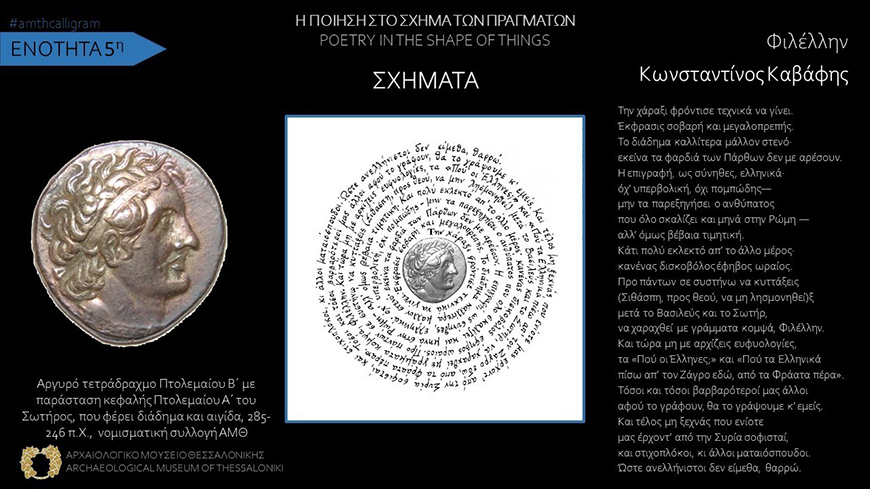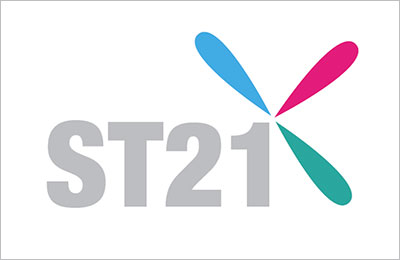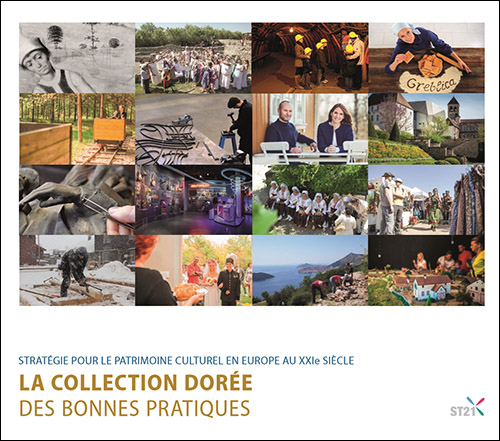Location of the initiative:

Initiator
Hellenic Ministry of Culture & Sports Archaeological Museum of Thessaloniki
Relation to Strategy 21 Recommendations:
S2 - make heritage more accessible
Time span of the initiative:
Start date: April 2020 / End date: June 2020
Motivation / Methodology
In the unprecedented circumstances of the nationwide lockdown against the spread of the COVID-19 pandemic, the Archaeological Museum of Thessaloniki (AMTh) continued cultivating its strong relationship with visitors and friends offering them the opportunity of a creative re-approaching of its antiquities. The online action “Poetry in the shape of things” was inspired by a type of visual poems whose text is arranged in such a way that it forms a thematically related image of an object that is described or referred in it. These poems are known as calligrams from the homonymous poetry collection by Guillaume Apollinaire in 1918, but their origins date back to the “technopaignia” of the Hellenistic era (c. 300 B.C.). The museum’s main goal was to re-introduce its antiquities as a source of inspiration, imagination, self-expression and creativity. The monuments could be “performers” of personal feelings and beliefs hidden in the chosen poems and texts as also witnesses of the current social conditions. The action was addressed to everyone regardless of age, educational level, or country of origin according to the AMTh’s philosophy: “a museum for all”. In fact, the museum encouraged the visitors to choose poems and texts written in their language and to “perform” them in the form of their favourite objects.
Additionally, the museum tried to encourage people to get through this difficult situation by drawing strength from the beauty, values and the comforting power of cultural heritage. The combination of ancient artefacts and contemporary poetry was one more challenge to suggest ways of creative connections with present and past artworks. The motivation for the museum stuff could be, perhaps, a personal one: it could represent the need to keep alive the optimism and courage through the ongoing activity and interaction with visitors and friends. The condition of social and spatial distance was a unique challenge for the museum curators, a way to test their professional readiness to renew the relationship of both the public and themselves with antiquities.
Methodology:
The museum produced online videos (https://www.youtube.com/watch?v=Hl7CJHH3ZgU&feature=youtu.be, https://www.youtube.com/watch?v=tpwEtz_1Z6Y&feature=youtu.be)
presenting two ancient objects of its collection as calligrams inviting visitors to be inspired and, following the instructions given step by step, to create their own calligrams rendering poems or other literary, even personal, texts in the shape of ancient or contemporary objects. In addition, people were called to send photos of their visual poems along with some personal information and thoughts via e-mail or share them on Facebook or Instagram (#amthcalligram). Finally, they could join in the museum’s online and ongoing exhibition of calligrams “Poetry in the shape of things” organized on the occasion of the “International Museum Day” on the 18th of May 2020. All calligrams were posting on museum’s social media daily and are included in the above mentioned exhibition on its web site (https://www.amth.gr/exhibitions/temporary/i-poiisi-sto-shima-ton-pragmaton). They are divided into 6 sections depending on the depicted object: 1. Antiquities of the AMTh, 2. Antiquities, 3. Human, 4. Nature, 5. Shapes, 6. Objects and Space. Every calligram has its own exhibition template with the name of its creator along with some of his/her thoughts and the name of the poet or author and the text of the poem or the used abstract of the novels. Six videos also present the calligrams per section:
- https://www.youtube.com/watch?v=cXQ6D-SOWYA&feature=youtu.be
- https://www.youtube.com/watch?v=ovr8Fn94UBc&feature=youtu.be
- https://www.youtube.com/watch?v=hCVdVK4NLj8&feature=youtu.be
- https://www.youtube.com/watch?v=Ysw1EknLYT8&feature=youtu.be
- https://www.youtube.com/watch?v=n6TCl7kjcZE&feature=youtu.be
- https://www.youtube.com/watch?v=EuFcU48SkvE&feature=youtu.be
Obstacles / Barriers
The main obstacle was the lack of the appropriate technical equipment and support as the whole project was organized at home. Any difficulties had to be faced in a simple, innovative, creative and flexible way and, in many cases, overtime work was required to solve the problems.
Change / Impact
The initiative enriched the museum's relationship with the public. The online followers which had been rather passive until then, were turned into an enthusiastic community supporting the museum and interacting with it in a creative and active way. Since then the museum's web traffic has skyrocketed. More and more people visited the museum’s site and social media looking for antiquities that would inspire them to create their calligrams or commenting the other visitors’ calligrams posted daily.
Lessons learned
The project reached people all over the world who cannot physically visit the museum regardless the COVID 19 pandemic (e.g. due to distance, disabilities, financial reasons, limited leisure time etc.). It also enabled over 200 individuals, from 5+ to 80+ years old, to express their personal feelings, memories and thoughts as well as their aesthetic preferences. Mainly, through their choices of texts, objects and language they had the opportunity to share their special cultural identity. Although most of the calligrams were created by Greeks with Greek poems and texts, people from other countries (USA, Spain, Italy, Great Britain, Turkey, Bulgaria) used poems, songs and other texts to express not only their culture difference but even their love to Greece choosing Greek contemporary poetry. It is important that one of our calligraphers was an Afghan teenager who and her family had been refugees in Greece some years ago; she created her calligram in the shape of the organ of the heart using a poem by her mother written in the Dari language. Older people used their calligrams to send messages of encouragement to their beloved ones as they could not meet each other because of the pandemic. Some calligrams were accompanied by photos of homelands and childhood or alluded to melancholy, fear, or hope for the condition of the pandemic. The participation of many class groups of elementary and high schools was also noteworthy as many students created their visual poems during the distance education in the days of lockdown.
Given the dominance of photography and videos in online communication in general, it was also a pleasant surprise to see the need of social media users to express themselves in a way that activated both their body and mind - a need that was probably particularly pressed due to the limited physical activity during the lockdown. We could say that the handwritten calligrams gave back the physical body to the web users and materiality to the digital space.
The action also introduced the meaningful power of poetry and literature as carriers of human hopes and anxieties. Finally, it highlighted the dynamics of monuments to mobilize emotions and imagination. So, we could say that the most important lesson was that: monuments could be not just “untouchable” exhibits, but they can touch our deeper self if we, as museum curators, think and activate “out of the (museum) box”.
Online resources
- https://www.facebook.com/archaeologicalmuseumofthessaloniki
- https://www.instagram.com/archmuseumofthessaloniki/
- https://twitter.com/intent/follow?screen_name=AM_Thessaloniki
- https://vimeo.com/amth
Contact information
Contact person: Angeliki Koukouvou; Styliana Galiniki
Email: [email protected] ; [email protected]
Organisation: Archaeological Museum of Thessaloniki, Greece
Email: [email protected]
Phone: +30 2313310201
Website: www.amth.gr
Source of financing
Public





